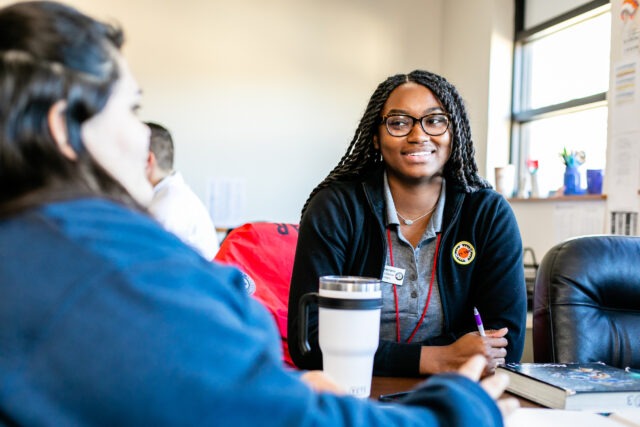Five things you should know before applying

Applying to serve with City Year
Are you considering applying to City Year? We’re very happy you’re thinking of serving with us, and we think you should know a few things before clicking submit.
Make sure you’re eligible and ready to commit
First things, first! Make sure you are eligible, ready for a challenge, and committed to serving schools and communities. To be eligible to serve, you must be between 17-25, a U.S. citizen or legal permanent resident and have completed high school or a GED. Additionally, you cannot have served more than three terms in an AmeriCorps state or national program, and you must agree to and pass a criminal background check.
Your City Year service will be challenging yet rewarding. As a City Year AmeriCorps member, serving as a student success coach, or one of our alternative role such as afterschool enrichment coach or school day learning coach, you’ll be receiving training and serving students and schools full-time for 11 months.
On average, you’ll serve all day Monday through Friday with occasional late nights and weekends. So, there will be long days! It will be important to first engage in a little self-care on those days but remind yourself why you initially chose to serve. Doing this will help you stay committed to the work throughout the year.
Surveys, feedback and focus groups on what makes a City Year AmeriCorps member successful has taught us that the corps members who get and give the most out of serving students and schools share three characteristics:
- They are deeply empathetic
- They are able to build strong relationships
- They bring a growth mindset—a belief that abilities are not fixed but rather can be developed through dedication and hard work
Additionally, our corps members want to make a real difference for students and schools, but they also want to learn valuable new skills most in demand in the workplace and gain access to exclusive grants and scholarships to advance their own careers or pursue more education post-service.
If this sounds like you, City Year could be a fantastic place for you to both build your own skill set and serve others.
Creating welcoming environments
As an organization, we’re dedicated to uniting, preparing and supporting teams of young people who want to make a positive impact on their world. This impact includes expanding access to educational opportunities in communities across the nation so that more students receive the resources, relationships and supports they need to succeed.
We partner with more than 200 public schools across 29 U.S. cities, collaborating with teachers to provide classroom support, one-one-one tutoring and small group instruction; run after school programs; encourage students to come to school; and foster engaging learning environments where everyone in the school community feels safe, welcome and valued.
This work is rooted in our commitment to creating positive, welcoming and human-centered work and school environments, where everyone feels a sense of belonging and connection, and where everyone can succeed and fulfill their potential.
Moving for service can be a challenge. We help where we can.
We’re committed to providing support and resources to help you find housing for your service year. Once you accept our offer to serve, will provide you with housing resources containing resources and connect you with local City Year alumni.
City Year acknowledges that many AmeriCorps members move long distances to their communities of service. These moves can be logistically challenging and financially straining. With that, City Year offers a one-time relocation allowance of $500 (pre-taxed) to any confirmed AmeriCorps member moving 50 or more miles.
When finding a place to live, we suggest you live either in or close to the community where you will be serving. Most AmeriCorps members will not be able to secure housing more than a month before their service begins. This is something all incoming AmeriCorps members should consider if planning to relocate for service.
AmeriCorps members receive benefits and support
City Year AmeriCorps members receive a modest, bi-weekly living stipend. When determining stipend amounts, City Year considers the cost of living in each of our 29 sites. So, stipend amounts will look different depending on where you chose to serve. As an AmeriCorps member, you’ll have access to health insurance, student loan forbearance for eligible loans, a childcare allowance, and in some sites, public transportation coverage.
Additionally, we know that service is not easy. Working in support of students, teachers and the community is rewarding but demanding work. We also recognize that AmeriCorps members are trying to manage life outside of service as well. While we encourage our AmeriCorps members to engage in self-care practices in their personal time, we also strive to make those opportunities for self-care readily available. For example, in May 2020, City Year teamed up with Talk Space—an online therapy platform that makes it convenient and straightforward to connect with a licensed therapist via video, text or phone—to provide AmeriCorps members with three free months of services.
Learn more about ways we’re striving to support corps mental health and well-being:
Professional development, education award and exclusive scholarships
During your service year, you will have access to various professional development and leadership opportunities to help launch your career in any field or further your education. AmeriCorps members receive leadership training, resume and cover letter writing workshops; attend networking events with alumni and partners; and, depending on the site, have access to a mentoring program with local corporate and nonprofit partners.
At the end of your service, you will receive the Segal AmeriCorps Education Award, worth $6,495 in 2022. You can use the award for tuition costs or pay back existing student loans. Additionally, as an alum, you will become eligible for exclusive scholarships, application fee waivers, and deferral opportunities to over 100 leading undergraduate and graduate colleges and universities.
Are you ready to apply?
Related stories
Learn from two City Year alums about how boundaries and healthy approaches to self-care helped them better support students.
Read more about Three self-care tips to support your well-being during AmeriCorps serviceCongratulations on starting your City Year journey! As a mid-year AmeriCorps member who begins service in the middle of the...
Read more about Four tips to help your mid-year moveAmeriCorps members starting in January add capacity to existing City Year teams and support even more students in reaching their...
Read more about What you can expect as a mid-year AmeriCorps memberCity Year and the State University of New York (SUNY) are building a multi-sector partnership to expand opportunities for college...
Read more about Multi-sector initiative aims to add value to college degrees and the workforce through service opportunities















